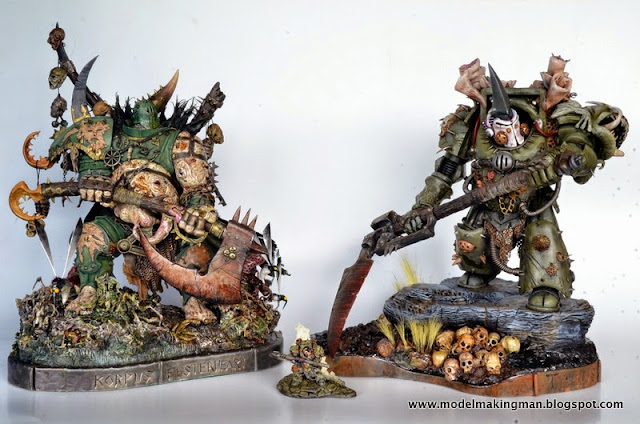Painting - I'm afraid this is the part of a project that I enjoy the least. Maybe, because of the amount of work that has gone into the build, I feel that it should be finished then, and yet there it is staring at me, unpainted and accusing. The trouble is, a familiarity with Games Workshop Golden Daemon paint jobs has put the stakes so high. I know what this model deserves in a finished form and yet also know that I probably will not be up to that standard.
Korpus took so long to paint in the GW style using their acrylics, that I decided to opt for oils, hoping that the large areas in a model of this size would lend themselves to the blending qualities of the oil paint.
This pic shows the body sprayed in an acrylic basecoat of various greens and the head, brush painted in the recommended Tanned Flesh. My source for the painting came from White Dwarf (GW's monthly magazine), number 382 Pg. 56, an article by Seb Perbet where he did a full Masterclass on Typhus, Herald of Nurgle.
The head is finished and finally glued in place. Remember that I mentioned something about not being happy with the length of his right forearm? Well I did a job on the offending limb and, with a fine bladed fret saw, cut about 1cm out of the middle of his arm. I then had the problem of bending the right hand and scythe handle backwards to allow the joint to be Araldited together. It was successfully joined but perhaps there could have been a bit more removed. Maybe much later in the future when it bugs me too much - but for the moment, it stands.
Various oil paints have been applied and the whole thing is slowly coming together. Those damn hive funnels were a pain to paint as different oil colours cover their underlying colours to vastly differing degrees. You can see here the shiny oils as opposed to the matt acrylics and just a positive hint of some successful highlighting.
Basing - Unlike painting, I really enjoy putting the model on a suitable base and try to make it add to the story of the character on it. This is the first time that the black baseplate had been permanently glued to a specifically shaped base board. The model had to be raised so that the scythe could swing free in space and a layer of polystyrene was added to a thinner layer of plywood.
Once finished, the hollowed out area seemed suitable and the rock shelf could be added. This started as a shaped piece of polystyrene pinned and glued to the black figure base.
I have started to cover the 'rock shelf' with Apoxie Sculpt which was then worked into horizontal, strata- like layers with a few random rock bulges added for geologic correctness.
Extra holes had to be drilled to help take some more skulls - I did not want to have to pick up that grinder again.
Here is a view of the back of the rock shelf showing some nice details added with the silicon tipped brush. Geologically speaking, it is a bit vesicular.
Love those skulls! Celluclay, a ready mixed papier mache product, makes a perfect groundwork, especially a muddy one. It was mixed with some earthy coloured acrylics and went on as this strange purple mud, liberally prodded with a large paint brush to form holes that would gather water and general liquid gunge.
Some tall grass was added, poked into areas that needed a bit of a lift. I think I added it because I had the stuff, but I quite like the effect even though the clumps are a bit 'wooden'. Must research on how to use tall grass clumps effectively.
Various GW washes were used all over the model, especially the rocks which had been painted in acrylics. I used Codex Grey, drybrushed with lighter greys, browns and a few greens. The mud was painted with browns, greys and black and then a mixture of inks - brown, chestnut, green and purple - was applied with a flow of Realistic Water,( a clear acrylic liquid used to make pools and puddles).
The only thing left to do was add a felt cushion on the bottom and this was easily done with PVA.
At last, it is done. These four views give a good all round idea of the Typhus model that I started on the 18th March 2013 and completed in early June. Much of that time was taken with the painting but if I ever become more proficient at that side of this modelling lark, then more monsters will be on the way.
Here are the two models together for their first family photo, along with with the GW miniature. I am quite pleased with how Typhus turned out but I will be making a list of a number of things NOT to do next time. The problem is, will I ever learn from my mistakes or will I just keeping inventing more of them? Time will tell.



















awesome looking mod, where did you get it?
ReplyDelete